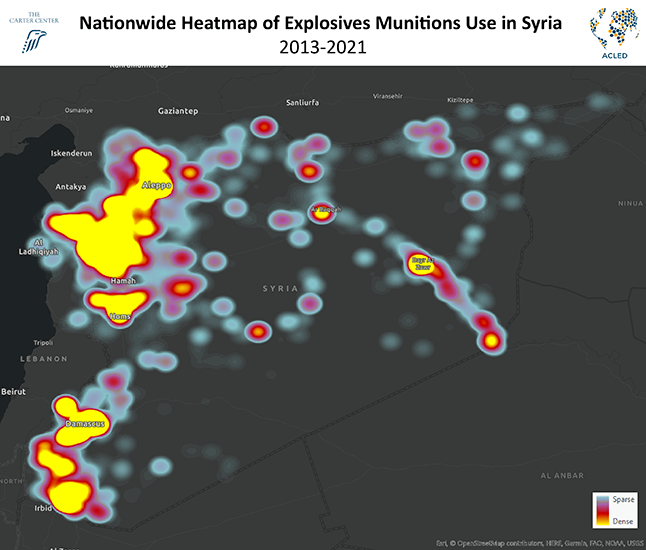By Hampton Stall, Senior Program Associate, The Carter Center
After the Mozambique civil war ended in 1992, demining experts needed 23 years to clear the 86,000 unexploded weapons left behind. A just-released Carter Center report suggests that there could be more than three times that amount of unexploded ordnance in Syria, where demining efforts have yet to begin.
The presence of unexploded ordnance is a critical impediment to Syria’s recovery and development, affecting the ability to farm, use roads, repair housing, or access schools, hospitals, and other essential infrastructure. Explosive remnants of war have a resounding impact on civilian life, economic activity, and environmental health.

The need to remove them is one of the few things that Syria’s warring parties and their international backers agree on, and the issue deserves the attention of the larger international community.
The Carter Center’s report is based on painstaking analysis of data collected by the Carter Center and obtained from the Armed Conflict Location Event Data Project. Researchers looked at conflict events across Syria dating back to 2012 and extrapolated the likely amount of unexploded ordnance in different areas based on reports of how many of each of a variety of types of weapons were used during a particular skirmish.
The result is an analysis that can be used to inform recovery efforts and negotiations. It illustrates why the international community should prioritize this issue and how it can address the problem.
The study recorded at least 972,051 uses of explosive munitions from 99,194 conflict events between December 2012 and May 2021. About 62% (599,954) of the total explosive munitions used in Syria were ground-launched munitions, and 37% (363,807) were air-launched munitions.
Estimates suggest that during a conflict, between 10% and 30% of weapons don’t explode. Applying that percentage to the data that the Center reviewed means that between 100,000 and 300,000 explosive munitions failed to detonate in Syria between December 2012 and May 2021. (And the count is likely much higher.)
These weapons need to be cleared to safeguard civilians, permit humanitarian aid, and ultimately encourage economic recovery. Demining efforts don’t just benefit the economy; they can also serve as confidence-building measures between warring factions and help build peace.
To begin to address this issue, The Carter Center recommends that:
Author’s note: The full report is available here, and the data set is more detailed than what is presented in the report. The Carter Center is available and willing to share more detailed analysis on this issue with potential partners.
Learn more about the Center's Syria Mapping Program here.
Please sign up below for important news about the work of The Carter Center and special event invitations.